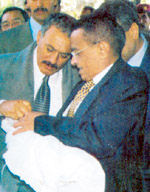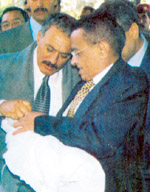
Immunization in Yemen [Archives:2001/19/Health]
May 7 2001
Prepared by Ismael Al-Ghabiry
Yemen Times

The principal target group are newly-born children who are protected against seven-vaccine-preventable diseases: diphtheria, whopping cough, tetanus, poliomyelitis, tuberculosis, measles, and hepatitis B. In 1987, the northern part of the country had one of the lowest immunization rates in the world with less than 25 percent of the children being immunized. The following year a country-wide immunization workshop was organized that aimed at preparing and implementing a child immunization program. The mechanism used to carry out the program focused on a decentralized and vertical approach at the governorate level. Planning and implementation were left to regional health directors while MOPH was responsible for supplies, social mobilization, monitoring and evaluation. A number of international agencies, notably UNICEF and WHO, and bilateral donors assisted the program by way of supplying hardware and software, including vehicles, vaccines, cold chain equipment and technical assistance.
For the success of any program of such dimensions, local support and community participation is most vital. This support was made available by the Governor of each governorate who mobilized political and community participation through meetings with tribal chiefs and local leaders. Efforts were focused on designated target groups with due regard to their specific needs, traditional attitudes and aspirations. Information on the program and its potential benefits were disseminated to the people in a language they could understand, using a variety of mass media and community channels, besides inter-personal communication.
A national plan of action was prepared that included regional targets, social mobilization activities, training programs, reporting and monitoring systems, cold chains, logistics and deployment. Immunization schedules were drawn up for the first, second and third round and implementation proceeded largely as planned. As a result, national immunization levels in the North rose dramatically to about 60 to 80 percent by 1990, more or less matching the standard that had already been achieved in the South.
After the initial backlog had been cleared, the important issue was to sustain a high level of coverage for children born after 1990. This required regular follow-up either through repeated national programs as the one in 1989/90, or through a more continuous program of immunization through the existing PHC network (integrated approach). Unfortunately, the economic and political problems during the first half of the 1990s prevented another national program while integrated programs through the PHC system remained weak. As a result, national immunization levels dropped to less than 30 percent by 1996-97. Through observation of National Immunization Day to eradicate polio which started in 1996 and concentrated hard work to improve immunization coverage, the MOPH managed to reach 72% nationwide coverage by the end of 1999. This was achieved by support given by WHO, UNICEF and other donors and partners. Policy makers may have to resume national programs while, at the same time, strengthening the immunization capability of the PHC system. Both approaches would need the support of an active health education program. Strengthening the immunization function of existing PHC facilities requires trained health workers, especially females, vaccines and refrigeration facilities as well as effective surveillance of pregnancies and births.
Immunization of infants is an important aspect of the broader issue of mother and child heath care (Reproductive Health). Mothers and infants are the most vulnerable population group and are facing severe health risks during delivery and in the pre and post-natal periods. In Yemen, these risks translate into high mortality rates; for mothers it is estimated to be 9 to 14 per thousand live births, and for infants about 80 per thousand live births. In addition, there is a high incidence of morbidity among mothers and young children.
The underlying causes are malnutrition, frequent pregnancies, exposure to endemic diseases, lack of proper pre and post-natal care, complications during pregnancy, and hazardous delivery conditions. Most births take place at home, almost all of them helped by traditional birth attendants or female family members. Only about one in eight women are delivered by qualified medical personnel. Most deliveries take places in an insanitary environment, causing fatal post-natal infections including tetanus.
To deal with these problems, more MCH facilities are needed and their quality would have to be upgraded. At this point, only about 20 percent of the PHC facilities are offering MCH services. Moreover, MCH care is often weak and suffers from inadequate training of health workers and shortage of supplies. Improving the situation requires a major effort to strengthen pre and post-natal care, reduce the risks of deliveries, and provide infants and small children with better health care. In addition, there is need for counseling on family planning to reduce fertility rates and prolong birth spacing.
Major components of prenatal care are physical examination of pregnant women, their immunization against tetanus, and advice on nutrition to expectant mothers. Deliveries should be conducted under aseptic conditions either at some or at a PHC facility in the presence of a trained birth attendant, (community midwives). Post natal care involves physical check-ups, advice on breast feeding and nutrition, lactation and weaning practices. Infants require immunization, monitoring of growth, detection of anemia and vitamin deficiency, and treatment of early childhood diseases of the digestive and respiratory system. Referral facilities and transport are needed for emergency cases.
——
[archive-e:19-v:2001-y:2001-d:2001-05-07-p:./2001/iss19/health.htm]


